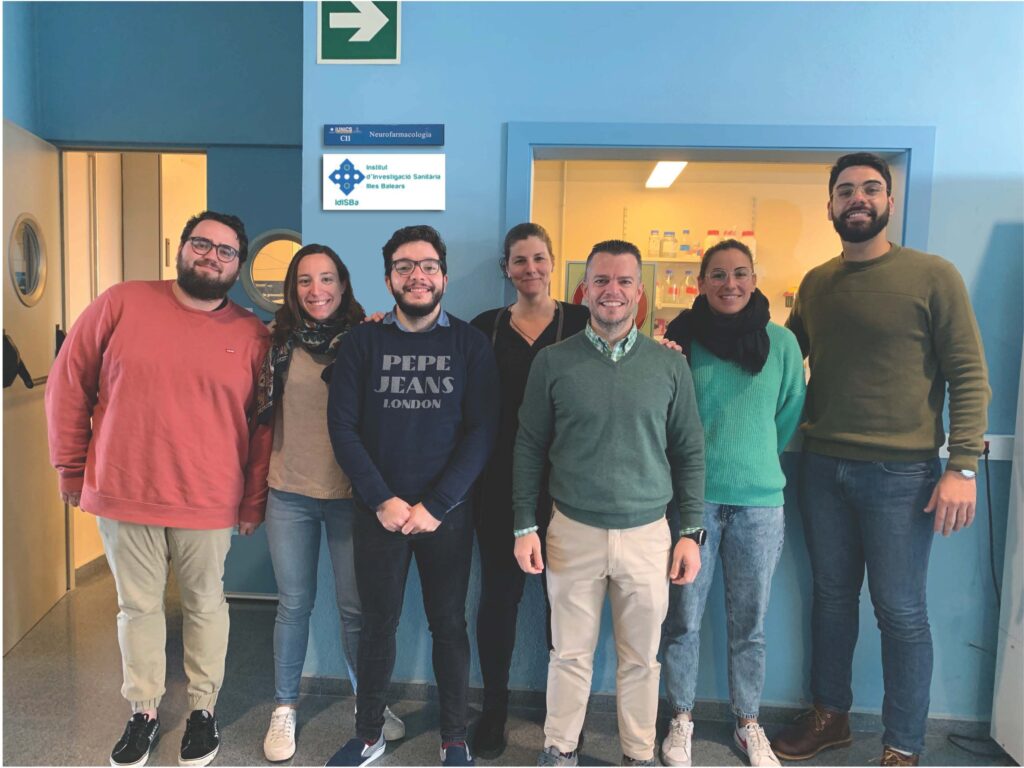In line with Word Depression Day we present the trajectory of the research group “Neuropharmacology” led by M. Júlia García Fuster from the University of the Balearic Islands
Who are we?
The Neuropharmacology research group, led by Dr. M. Julia García Fuster, is located at the University Institute for Research in Health Sciences (IUNICS), at the University of the Balearic Islands, and belongs to the Research Institute Sanitaria Islas Baleares (IdISBa). At present, the group is made up mainly of junior researchers who develop the lines of research described below. Specifically, Dr. Fernando Yáñez Gómez, Dr. Elena Hernández Hernández, Dr. Cristian Bis Humbert, and PhD students Sandra Ledesma Corvi, Carles Colom Rocha and Jordi Jornet Plaza.
What is the line / s lines of investigation that the group follows?
The group works, from a preclinical perspective and including sex as a biological variable, in the investigation of the neurobiological and behavioral bases of various psychopathologies in animal models. Specifically, the main lines of research are: (1) Neurobiology of depressive syndrome in adolescence: preclinical evaluation of the efficacy of various antidepressant treatments; and (2) Neurobiological and behavioral consequences derived from the consumption of drugs of abuse during adolescence: psychiatric comorbidity in adults.
What type of depression is the research focusing on?
Depressive syndrome in adolescence, as well as in drug addiction-depressive disorders comorbidities.
What new data has been generated in the group?
Our latest data are focused on evaluating the differential efficacy of various antidepressant treatments for depressive syndrome in adolescence in animal models of stress at an early age (pro-depressive phenotype) and incorporating sex as a biological variable (given the lack of pre-existing studies). -clinicals and the high incidence of depression in women). Specifically, our data, in line with other data in the literature, reveal important differences in the antidepressant effects exerted by treatments of various kinds (eg, ketamine, cannabidiol, electroconvulsion therapy) as a function of age (different efficacy in the adolescent stage) and sex. In this context, our long-term objective aims to deepen these results and provide preclinical data to develop improved therapies for the adolescent population, and directed for each sex, and thus optimize the translation of the results to clinical practice. In addition, the characterization of new antidepressants for adolescence also helps us to evaluate possible treatments to alleviate and / or prevent the negative effects that emerge after drug use in the early stages of life.
Latest published works
In the context of these lines of research, a selection of the articles published in recent years is detailed below:
- Bis-Humbert C, García-Cabrerizo R, García-Fuster MJ: Decreased sensitivity in adolescent versus adult rats to the antidepressant-like effects of cannabidiol. Psychopharmacology, 237: 1621-1631 (2020).
- García-Cabrerizo R, Ledesma-Corvi S, Bis-Humbert C, García-Fuster MJ: Sex differences in the antidepressant-like potential of repeated electroconvulsive seizures in adolescent and adult rats: Role of the early stages of hippocampal neurogenesis. European Neuropsychopharmacology, 41: 132-145 (2020).
- Bis-Humbert C, García-Cabrerizo R, García-Fuster MJ: Dose-dependent opposite effects of nortriptyline on affective-like behavior in adolescent rats: comparison with adult rats. European Journal of Pharmacology, 910: 174465 (2021).
- García-Cabrerizo R, García-Fuster MJ: Adolescent cocaine exposure enhanced negative affect following drug re-exposure in adult rats: Attenuation of c-Fos activation. Journal of Psychopharmacology, 33: 154-162 (2019).
- Bis-Humbert C, García-Cabrerizo R, García-Fuster MJ: Increased negative affect when combining early-life maternal deprivation with adolescent, but not adult, cocaine exposure in male rats: regulation of hippocampal FADD. Psychopharmacology, 238: 411-420 (2021).
- Bis-Humbert C, García-Fuster MJ: Adolescent cocaine induced persistent negative affect in female rats exposed to early-life stress. Psychopharmacology, 238: 3399-3410 (2021).
- Bis-Humbert C, García-Cabrerizo R, García-Fuster MJ: Antidepressant-like effects of cannabidiol in a rat model of early-life stress with or without adolescent cocaine exposure. Pharmacological Reports, 73: 1195-1202 (2021).
- García-Cabrerizo R, Bis-Humbert C, García-Fuster MJ: Electroconvulsive seizures protect against methamphetamine-induced inhibition of neurogenesis in the rat hippocampus. NeuroToxicology, 86: 185-191 (2021).
- Hernández-Hernández E, García-Fuster MJ: Evaluating the effects of 2-BFI and tracizoline, two potent I2-imidazoline receptor agonists, on cognitive performance and affect in middle-age rats. Naunyn-Schmiedeberg’s Archives of Pharmacology, 394: 989-996 (2021).


